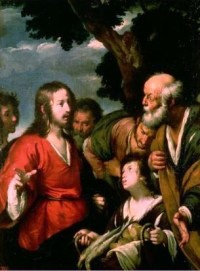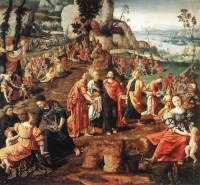St. Philip's Cross
The reason why the Apostle Philip (one of the Twelve Apostles of Jesus) is associated with that food is simply because one of the few mentions about Philip in the Bible (John 6:7) is when he expressed serious concern to Jesus about feeding the group of thousands of people from only five loaves and two small fish.
This page will explain what happened next.
But first, let's address a common misconception that the St. Philip's Cross should be a horizonal Latin Cross, shown on the right.
Lots of stories have been written about Philip but most are apocryphal accounts and obvious legends; the only solid accounts we have are in the Bible.
Dubious accounts include Philip and Bartholomew preaching at Hierapolis at a temple used for serpent worship. There, Philip killed a huge serpent (or dragon, by some versions), an act which rather upset the temple's high priest. Both Philip and Bartholomew were crucified upside down in front of the serpent worshippers.
While they were dying on the crosses, a strong earthquake began and Philip prayed aloud for the safety of the people and continued preaching. The earthquake knocked everyone to the ground and also toppled the crosses, which may explain why some feel the Sideways Cross is a suitable symbol.
Another account is that he was beheaded in the city of Hierapolis, not crucified. Further accounts say he died peacefully though old age.
The basis for those legends in unclear, but the canonical Gospel John 6:7 is perfectly clear, and therefore we'll stay with the Loaves and Fishes for St. Philip's Cross.
Jesus performed a spectacular miracle by feeding the thousands with such a small amount of food.
And when they'd eaten enough, the leftover crumbs filled twelve baskets. He performed a similar miracle later with seven loaves and seven baskets of leftovers.
But did it actually happen? If only we had a time machine to go back a couple of thousand years and verify such stories.
So here's a thought...
The Bible reminds us that things in this life come to pass (KJV has 163 instances of "comes to pass" and 456 instances of "came to pass"). Both you and I too came, and in a relatively few short years we'll die. With our comforting belief that Christ's salvation has bought us a ticket to eternal bliss in heaven, we'll find ourselves in a dimension where time, as we know it, does not exist. Will that mean we can travel 'back' in time to Galilee and see what really took place?
Why not? It sounds a fun thing to do. Anyway, what else could we do to pass the eternal time 'up' there? We could hop onto a heavenly cloud, float down to Galilee, c. 30 AD, sit on a tree and watch what happens.

The Miracle of the Loaves and Fishes, a painting by Bernardo Strozzi
(Click either image to enlarge)
The Miracle of the Loaves and Fishes, a painting by Lambert LombardScenario one: Ah! There he is; that little boy. Yes, he does indeed have five loaves and two fishes. And here comes Andrew to introduce the boy to Jesus.
Wait a minute... Yes, Jesus has taken the bag and he's handing out loaf after loaf, fish after fish. Just like one of those magicians you see on TV who a pull a rabbit from a top hat. But this magician is not just like the others. Sure, he's got the flowing robes that could conceal a few extra loaves of bread. But enough to feed thousands?
This is not a magic trick; it really is a miracle.
Scenario two: Jesus takes the bag of five barley loaves and two small fish, but nobody is hungry so nobody accepts the food.
Does that sound likely? Thousands of people, having rushed from their homes from the surrounding towns into the countryside, without time to prepare a picnic, and nobody is hungry hours later? Amazing! Maybe not a miracle, but amazing nonetheless. However, the unlikely 'not hungry' scenario doesn't address the twelve baskets of leftovers.
What was Jesus doing there anyway? He was saddened by the execution of John and no doubt wanted a bit of time on his own, but all these groupies flocked after him. Rather than tell them to go away, "he had compassion on them and healed their sick".
We are not told how many people he healed, neither are we told what sicknesses he healed. Such multiple healing is surely a miracle and yet the details are not recorded. What we have is a precise number of loaves, fishes and baskets. These items are, for some reason, much more important than the miraculous healing. So what is the significance?
For the story of the loaves and fishes to last so long, something really miraculous must have happened.
Something really miraculous must have happened? Says who? Fairy tales have lasted much longer than two thousand years, so let's look at our third and most cynical scenario.
Scenario three: There was no miracle. There wasn't even a gathering on the hillside. There wasn't even Jesus. It's all a big fairy story.
This is the easiest to accept because no proof is necessary to say something didn't happen 2,000 years ago. But in this story, the events were pivotal to a much larger picture.
If we deny this story then we are denying the very existence of Jesus. And then we're all in serious trouble!
Putting aside for the moment whether the events happened in exactly the way recorded in the Scripture, what does this story itself mean?
Significance
For the cross image on this page, the arrangement of loaves and fishes on a dinner plate page mimics the Celtic Cross, but a Loaves and Fishes Cross could be any design which includes items used in the miracle. The cross symbolises the passion of Jesus, the loaves remind us that He is the "bread of life", and the fish is a common symbol for Jesus Christ (see Ichthys). Arranged almost in Yin-Yang fashion, they represent the dual nature of Jesus Christ.
The fish is also a symbol of baptism. Fish swim in deep water yet do not drown; indeed, they need to be immersed in water in order to survive. Similarly for us to survive spiritually, we need to be baptised by immersion into the waters of Christ's love.
Jesus referred to the twelve filled baskets when he spoke with his disciples. And just as the twelve baskets were filled, so were the Twelve Apostles filled with the love of Jesus. When Jesus departed it was important for the Apostles to be filled with the 'leftovers' so they could continue the work Jesus had begun.
The significance of the five and seven is rather cryptic in that 5 + 7 = 12. The number five reminds us of the Five Wounds of Christ and seven is frequently seen in the Bible. Just as the week is complete after seven days, the number seven can be related to completeness and wholeness. (The Early Church was more fond of numerology than the Church is today.) "I am the bread of life" is one of the seven I AM's of Jesus. Twelve of course refers to the disciples, a number that has grown significantly over the past two millennia.
The Greek Orthodox priests today carve pieces of Communion bread out of five loaves that are prepared for the Eucharistic celebration; the Russian Old Believers use seven loaves.
Jesus performs a second miracle with loaves and fish to emphasize that the forgiveness of God is not just a one-time event. If we sin again, His love is such that He will forgive us our sins again. He refers to a similar miracle at the time of Moses, who provided manna to the children of Israel in the wilderness. But in the loaves and fishes miracle, Jesus is talking about the bread of life.
In the story of Elisha who fed 100 men with only twenty loaves we read: "the LORD says: They will eat and have some left over." The love of God is the same. We can accept His love, be filled with His love, and yet there will still be some left over.
And that is the real miracle of this story.
(For a bit more about the Loaves and Fishes, see the Wavy Cross.)
And finally...
Here are some crumbs of useless facts.
- The hardness of butter is directly proportional to the softness of the bread.
- Half of all children who grow up in bread-consuming households in Scotland, score below average on standardized tests.
- Just one small loaf of bread, if frozen and dropped from a tall building, could kill a passer-by instantly.
- Most bread eaters are unable to distinguish between significant scientific fact and meaningless statistical babbling. We trust you are not one of those!
How much bread? Quite a lot, even by conservative estimates. Matt. 14:21 tells us there were 5,000 men plus an unknown number of women and children. Plus beggars, slaves and other outcasts who were not entitled to be called 'men'. But being conservative, let's assume there were only 5,000 people and let's assume also that the loaves were relatively small, say 200 grams and 20 cm x 10 cm x 10 cm. Multiply that by 5,000 and you have 1,000 kg of bread (about the weight of a medium-sized car) measuring 10 cubic metres. Concealing that amount of bread in a magician's robes would take a miracle. Ah! And where did the twelve baskets come from?
Another way of looking at this: Even the leftovers, the scraps, the outcasts, the sinners, all are included and there is a place for them in the Kingdom of Heaven. See Meaning of the Cross.
John 6:22-59
2 Kings 4:42-44
"And Jesus said to them, "I am the bread of life. He who comes to Me shall never hunger, and he who believes in Me shall never thirst." John 6:35
As you know, the common plural is 'fish', and 'fishes' when referring to different species of fish:
"There are many fish in the sea."
"These four Gold fish and four Bloodfin Tetra fish were not too expensive. These fishes are the most popular for home aquariums."
For the miracle, the KJV version of the Bible uses "fishes", and the NET version uses "fish". This is more likely to be Old English vs. contemporary English than suggesting different or same species of fish. And yet allegorically it serves to remind us that whatever age, race, sex, political leaning, or other trait we may have, Jesus died for us all equally.
(Yea, even for the local bakers who were just loafing around, unhappy because there were no hungry customers when the multitude went home!)
Before we delve into the canonical scriptures, here's a comical monologue about George and the Dragon

